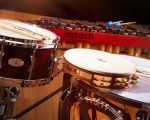Exploring the Fascinating Families of Musical Instruments
- Introduction to Musical Instrument Families
- String Instruments
- Wind Instruments
- Percussion Instruments
- Keyboard Instruments
- Real-life Examples of Musical Instrument Families
1. Introduction to Musical Instrument Families
Music has always been a powerful medium for human expression, and understanding the different families of musical instruments is essential for anyone interested in exploring the world of music. Musical instruments can be broadly categorized into several families, each with unique characteristics and sound qualities. These families are fundamental to how music is composed and performed, with each one playing a vital role in shaping the overall sound of a piece.
2. String Instruments
String instruments, as the name suggests, produce sound through vibrating strings. These instruments are among the oldest known to humankind and are integral to many genres of music, from classical to contemporary. The family of string instruments includes instruments like the violin, cello, guitar, and harp.
One of the key features of string instruments is the method of sound production, which can be done by bowing, plucking, or strumming the strings. For example, a violin is played by drawing a bow across the strings, while a guitar is strummed or plucked with the fingers. The tone of string instruments can vary widely, from the delicate and sweet sound of a violin to the deep resonance of a cello.
3. Wind Instruments
Wind instruments produce sound by the vibration of air, typically blown through a mouthpiece or reed. This family includes brass and woodwind instruments, each with its own distinctive sound. Brass instruments such as the trumpet, trombone, and tuba produce a brassy, bold sound, while woodwind instruments like the flute, clarinet, and saxophone have a softer, more melodic tone.
Woodwind instruments can be further categorized into those with reeds (like the clarinet) and those without (like the flute). The brass family, on the other hand, produces sound through the buzzing of the player’s lips in a mouthpiece. Wind instruments are widely used in orchestras and bands, and they provide the music with both melody and harmony.
4. Percussion Instruments
Percussion instruments are unique in that they create sound by being struck, shaken, or scraped. This family is one of the largest, including drums, cymbals, tambourines, xylophones, and even unusual instruments like maracas and cowbells. Percussion instruments are essential for keeping rhythm in music and can also provide dramatic effects through their varied sounds.
The drums are perhaps the most well-known percussion instruments, with varieties like snare drums, bass drums, and bongos, each offering different textures of sound. Other percussion instruments, such as the xylophone and marimba, are tuned to produce specific pitches, making them useful for melody and harmony as well.
5. Keyboard Instruments
Keyboard instruments, such as the piano, organ, and harpsichord, are played by pressing keys, which in turn activate hammers or other mechanisms that produce sound. The piano is one of the most iconic instruments in the world, known for its ability to produce both melody and harmony simultaneously. The organ, with its powerful sound, is commonly found in churches and grand halls.
The harpsichord, a predecessor of the piano, produces sound through plucking strings, giving it a distinct, sharp tone. Keyboard instruments can range from traditional acoustic pianos to modern synthesizers, offering a vast array of sounds and styles for musicians across genres.
6. Real-life Examples of Musical Instrument Families
Understanding the different families of musical instruments can help you appreciate their role in music more deeply. For instance, in orchestras, the string section typically provides the backbone of the melody, while the wind section adds rich harmonies, and the percussion section drives the rhythm. In popular music, bands often rely on a mix of string (guitar, bass), wind (saxophone), and percussion (drums) instruments to create their sound.
Many famous musicians and composers have utilized various instrument families in innovative ways. Take the example of Beethoven, who utilized a full orchestra of string, wind, and percussion instruments to create symphonies that have endured for centuries. Or consider modern rock bands, where the combination of electric guitars, drums, and keyboards forms the core of the sound that defines the genre.
As you explore the diverse families of musical instruments, you’ll gain a greater appreciation for the way they contribute to music in all its forms. Whether you’re a musician or just a fan, understanding the families of musical instruments will deepen your connection to the art of music.
If you're considering learning an instrument, understanding the different families can help you decide which one aligns best with your interests and skills. For more insights on various musical instruments and to find the perfect instrument for you, explore our collection of high-quality instruments!








